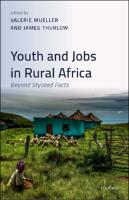Youth and Jobs in Rural Africa
Beyond Stylized Facts
| dc.contributor.editor | Mueller, Valerie | |
| dc.contributor.editor | Thurlow, James | |
| dc.date.accessioned | 2020-04-29T08:28:59Z | |
| dc.date.available | 2020-04-29T08:28:59Z | |
| dc.date.issued | 2019 | |
| dc.identifier.uri | http://library.oapen.org/handle/20.500.12657/37432 | |
| dc.description.abstract | Theories underlying the relationship between urbanization and transformation are being challenged by trends in Sub-Saharan African countries, since many have yet to observe their own “green” or industrial revolutions, despite moderate urbanization. Africa’s trajectory is very different than those of other developing regions, a main reason for which is the region’s significant “youth bulge” and the lack of a labor market outlet for this growing subpopulation. In many countries, the youth are driving the (albeit slow) movement out of agriculture, yet rather than migrating to urban areas, many are finding (usually informal) work in secondary cities, their peri-urban spaces, and the rural nonfarm economy. This book examines the overall trends in youth migration, policies, and political activism, then looks specifically at five African case studies to identify key trends and provide recommendations on encouraging youth to spur structural change. Conclusions reached in this book include that the rate of structural transformation varies among countries in Sub-Saharan Africa, but in most cases, it is the youth who are driving these changes. Education, access to financial services, and agricultural productivity contribute to this structural transformation and can act as pushes or pulls out of agriculture for the youth. However, when structural transformation policies are not pro-poor or inclusive, it can result in higher levels of youth under- and unemployment. Thus, the conclusions point to recommendations focusing on agricultural productivity, the rural nonfarm economy and informal sectors especially along agriculture value chains, access to finance and savings, infrastructure, and education. | en_US |
| dc.language | English | en_US |
| dc.subject.classification | thema EDItEUR::K Economics, Finance, Business and Management::KC Economics | en_US |
| dc.subject.classification | thema EDItEUR::K Economics, Finance, Business and Management::KC Economics::KCM Development economics and emerging economies | en_US |
| dc.subject.classification | thema EDItEUR::K Economics, Finance, Business and Management::KC Economics::KCF Labour / income economics | en_US |
| dc.subject.classification | thema EDItEUR::K Economics, Finance, Business and Management::KC Economics::KCV Economics of specific sectors::KCVD Agricultural and rural economics | en_US |
| dc.subject.other | youth | en_US |
| dc.subject.other | employment | en_US |
| dc.subject.other | migration | en_US |
| dc.subject.other | structural transformation | en_US |
| dc.subject.other | national policies | en_US |
| dc.subject.other | political participation | en_US |
| dc.subject.other | Sub-Saharan Africa | en_US |
| dc.title | Youth and Jobs in Rural Africa | en_US |
| dc.title.alternative | Beyond Stylized Facts | en_US |
| dc.type | book | |
| oapen.identifier.doi | 10.1093/oso/9780198848059.001.0001 | en_US |
| oapen.relation.isPublishedBy | b9501915-cdee-4f2a-8030-9c0b187854b2 | en_US |
| oapen.pages | 336 | en_US |
| oapen.place.publication | Oxford | en_US |
| oapen.remark.public | Funder name: IFPRI : International Food Policy Research Institute |

